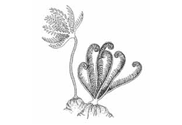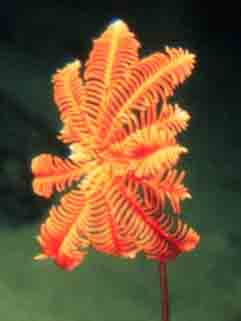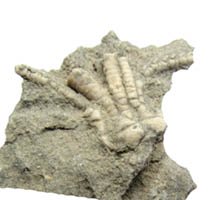Sign up for Lesson Plans, discounts & more!
Crinoids
Crinoids: You've come to the right place to learn the facts about these living fossils you’ll tell your friends about.
These unusual, beautiful and graceful animals are living fossils. That is they have been around for about 450 million years and can still be found in the oceans today. They are members of the phylum Echinodermata. This is the phylum that brings you starfish, sea urchins, and sand dollars. Like all members of this group they share similar traits, like a five part radial symmetry, exoskeletons made of hard plates called ossicles, and a water vascular system.
The crinoids are a breed apart however, they resemble an underwater flower. Some even have parts that look and act like roots anchoring them to the ocean floor. They are commonly called sea lilies. Their graceful stalks can be meters long. Other varieties have no stalks or root like parts. They are commonly known as feather stars. Unlike the sea lilies the feather stars can move about on tiny hook like structures called cirri.
 Crinoids
CrinoidsCrinoids - The Living Fossil
But wait it sounds like a description of living animals. I thought these pages were about fossils! Well right on both counts. Crinoids are alive and well and living in an ocean near you! They are also some of the oldest fossils on the planet. The earliest come from the Ordovician Period. At least the earliest that everyone agrees on. There is a class called Echmatocrinus that date back to the middle of the Cambrian Period but most paleontologists don’t count them to be true crinoids. Oh, to belong... Most of the Paleozoic forms died out in the great Permian extinctions. The few species surviving into the Mesozoic Era thrived. Many new species evolved during this time including the ancestors of the present day class Articulata.
Photo:US NOAA
These echinoderms were at their height during the
Paleozoic era. They could be found all over the world, creating forests
on the floor of the shallow seas of this time period. There were so
many in places, that thick limestone beds were formed almost entirely
from their body parts piled on top of each other.
Crinoids of today tend toward deeper waters. You won’t see them on your
next snorkeling adventure. The stalked varieties are usually found in
water over 200 meters deep, though some can be found 100 meters deep.
The unstalked varieties, comatulids also live in deeper waters though generally not as deep as the sea lilies.
So
the really cool thing is that scientist can study living relatives of
fossils that are 450 million years old. While these living crinoids are
not the same species or orders as those of the past there are enough
similarities to help us understand how these plant like animals lived.
Crinoids
fossilize readily and so there is an abundance of them to be found,
mostly stalk fragments. There are 2 reasons for this.
• The ocean floor is a good environment for fossilization to occur. See fossil formation.
• Their skeletons are made of calcareous plates. This is a hard rock like material.
Find crinoids for sale at our sister site fossilicious.com
Classifying Crinoids
Classification phylum: Echinodermata
Class: Crinoidea
Orders: Articulata, (living)
Cladida, extinct
Flexibilia, extinct
Camerada, extinct
Disparida, extinct
A buyer's guide to crinoid fossils
click here for a description of the parts of a crinoid
Try our Crinoids Crossword Puzzle
Try our Crinoids Wordsearch
Check out some of the Educational Materials for sale on our sister site fossilicious.com.

interested in more? If so, you may want to check out our other sites:
fossilicious.com - Our online fossil and mineral rock shop.
rocksandminerals4u.com - An educational site about rocks, minerals, and geology.
Geologic Time Geologic Time Line
Cenozoic Era
Quaternary
Neogene
Paleogene
Mesozoic Era
Cretaceous
Jurassic
Triassic
Paleozoic Era
Permian
Carboniferous
Devonian
Silurian
Ordovician
Cambrian
Archean Time
Hadean Time
Teachers Resources
Activities for Education and Fun
Earth Science Lesson Plans
Activities For Kids
Fossil Lesson Plans
Fossil Activities
Education Articles
Coloring Pages
Dinosaur Coloring Pages
Montessori Materials
Geology Club
Fossil Hunting
 |
 |
 |







